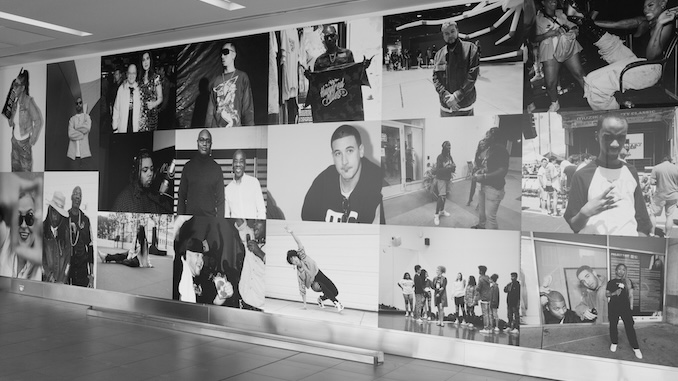In an age where cultural narratives shape our understanding of communities, Project T-Dot by Ajani Charles offers a unique insight into the hip-hop scene of Toronto through an 18-year-long documentary initiative that has been primarily photography-based. Torontonians and visitors to the city alike got a glimpse of part of Project T-Dot when they were first introduced to it at City Hall a couple of years ago. Its most recent exhibit launched earlier this year and occurred soon after the celebration of the 50th anniversary of hip-hop. It showcases our city’s impact and evolution within the scene through portraits, live concert photography and images from various events, among other moments in the scene. This exhibit, marked by its poignant black and white imagery, captures the dynamism of breakdancers, rappers, DJs, graffiti artists and other contributors within the greater hip-hop community – world-renowned and those lesser known.

The Genesis of Project T-Dot
Ajani Charles, a Toronto-based photographer, lauds hip-hop’s vibrancy and cultural significance through his works. The project, detailed on his website ajani.ca, highlights a rhythmic synthesis of sound, movement, and visual artistry unique to Toronto’s hip-hop scene.
The project began back in December 2006 and has continued ever since. Through connections, backstage visits, chance encounters and photography gigs in the scene, Charles has managed to capture significant milestones in the careers of artists like Drake, Shawn Desman and The Weeknd while also featuring culturally substantial individuals in the scene like Play Da Record’s Eugene Tam, 1 LOVE T.O. and E-Talk’s Tyrone “T-rexxx” Edwards, and MuchMusic’s Master-T. The exhibit is not just about people but also organisations such as Hong Shing Restaurant, MuchMusic, Roots Rhymes Collective, The Circle, The Forgiveness Project, The Toronto Raptors, and Too Black Guys, all of which play a significant role in the cultural mosaic of Toronto’s hip-hop scene.
Through Charles’ lens, each black and white snapshot immortalises ephemeral and expressive moments, thus preserving hip-hop’s fluid narratives. Each photograph’s meticulous framing and timing indicate Charles’ deep understanding and respect for the culture and its participants.

The Exhibition Dynamics
What was introduced through an insightful display at City Hall has now transitioned into a similarly impactful and more interactive exhibition at Billy Bishop Toronto City Airport. The City Hall exhibit showcased 34 images featuring 60 participants, while the current exhibition at the airport boasts 60 vinyl prints capturing over 80 individuals. This expansion enriches the visual narrative and offers spectators a broad spectrum of the community’s artistic endeavours.
Some of my favourite images capture the lesser-publicised aspects of hip-hop, such as Graffiti and Breakdancing. Breakdance crews like Bag of Trix and Ground Illusionz, with members like Benzo, are featured in the imagery. Artwork from arguably Canada’s most well-known Graffiti writer, SKAM, is also featured.
Technological Integration
A standout feature of the current exhibition is the 55-inch touchscreen accompanying the displayed prints. This digital interface offers visitors detailed descriptions of the images, delving deeper into the backgrounds of the individuals and contexts depicted in the photographs. Further enriching the experience, a short film related to the exhibit continuously streams via this touchscreen. Through a partnership with PATTISON Outdoor Advertising, the film will be showcased across Toronto’s transit lines and the PATH this summer, making the exhibit of Toronto’s hip-hop scene accessible to a broader audience.

Highlighting Community Impact
Project T-Dot frames artistic expressions and signifies the influence of organisations that contribute immensely to the community. Initiatives like Honey Jam, The Remix Project, Operation Prefrontal Cortex, and Manifesto Community Projects play pivotal roles in nurturing and fostering talents within the hip-hop arena in Toronto.
The displayed images and the embedded stories illustrate the transformative power of such supportive networks in the lives of artists, who utilise these platforms to amplify their voices and skillsets in creative, constructive modes.
Short Film
In addition to the powerful visual narratives crafted through photography, Ajani Charles has produced a compelling short film that extends the narrative of Project T-Dot within the exhibition at Billy Bishop Toronto City Airport. The cinematic portrayal of the themes captured in the static images is embodied in the film, which delves into the making of the exhibition, offering behind-the-scenes clips of prominent figures featured in the photographs, including renowned personalities like Drake, Director X, and Eugene Tam. Viewers are treated to intriguing footage of the pictures being printed and prepared for display, providing a glimpse into the technical and creative processes involved.
Additionally, the film includes a short biography of Ajani Charles, shedding light on the creative mastermind behind the project and an introduction to the exhibition’s setup at the airport. Through these elements, the film outlines the background and history of the exhibit. It expands on its scope, offering a deeper understanding and appreciation of the cultural tapestry that Project T-Dot represents. It celebrates Toronto’s hip-hop culture through a multidimensional showcase.
Foreseeing the Cultural Trajectory
As Project T-Dot continues to woo and engage visitors at Billy Bishop Toronto City Airport until 2025, its legacy is already taking shape. By capturing the raw, uncensored narratives of hip-hop, Ajani Charles doesn’t just document a subculture; he celebrates an evolving cultural revolution. These narratives’ ongoing and increased exposure, mainly through additional mediums like digital displays in public spaces and continuous looping short films, forecasts a robust dialogue about cultural diversity, artistic expression, and community dynamics.
Ajani Charles’ Project T-Dot transcends the traditional boundaries of a photo exhibit. The project serves as a cornerstone of cultural preservation and education by powerfully intertwining visuals with technology and heartfelt narratives within Toronto’s hip-hop community. It involves far more elements than is evidenced by the current exhibit, such as a coffee table book and a full-length movie that are currently in the works. This exhibition documents the evolving landscape of hip-hop and sets a precedent for future cultural documentation, underscoring the potent blend of art, technology, and community engagement.
This article encapsulates Project T-Dot’s vitality and impact, comprehensively covering this culturally significant exhibition.
This post was originally published on this site be sure to check out more of their content.






